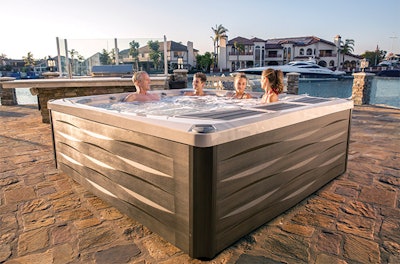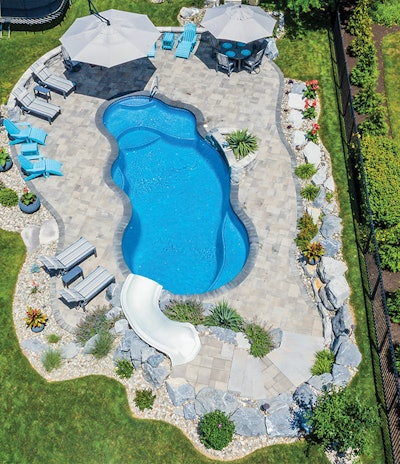
The pool, hot tub and spa industry experienced unprecedented growth in 2020, and it appears the industry will continue to see similar growth throughout 2021. Now that we are one month into the new year, PHTA members are predicting what the top trends for the industry will be in 2021.
1. COMPLETE OUTDOOR ENTERTAINMENT SPACE
With people spending more time at home, they are also investing more money into their homes — and their yards. They're looking for ways to make their outdoor space an extension of their living space. Previously, people may have just wanted a barbecue area, a patio or a swimming pool. Now, they want it all.
"Everyone wants a complete backyard experience," says Addam Barrow, regional sales manager at Blue Square Manufacturing and president of the PHTA Austin Chapter. "In lieu of spending money on their travel experiences, homeowners are investing that money into their backyard experience now."
The total backyard is "one of the mega-trends that I think builders, companies, retailers and sales professionals are focused on," agrees Joe DeFuria, director of brand development at Taylor Technologies and chair of the PHTA Retail Council. "It's that staycation; people are investing in their home because that's where they've been."
RELATED: Add Excitement and Stir
What sort of features could be included in a total backyard? Fire pits, outdoor fireplaces and outdoor kitchens are some of the most popular options. There is also higher demand for pergolas, pavilions and larger seating areas. Improving the overall landscaping of the yard is becoming a priority to homeowners as well.
"The al fresco lifestyle that is so popular on the West Coast is starting to move over here," says Bob Blanda, president of Mill Bergen Pools in Brooklyn, N.Y., and member of the PHTA Board of Directors. "I'm seeing a lot of designs that are trying to make the outside space look a lot
like the inside space." This can be accomplished in a number of ways, such as using complementary materials or constructing the outdoor space so that it flows directly from the indoor space.
2. ADDED FEATURES
New pool customers are choosing to purchase additional features that they may not have considered prior to the pandemic.
Dan Lenz, vice president of All Seasons Pools & Spas, Inc. in Orland Park, Ill., and president of the PHTA Midwest Chapter, explains this with a hypothetical. If a family normally goes to the Bahamas for vacation but can't this year, what is it that they like about the resort that they could bring to their own pool? "[The resort] has a waterfall, a slide, maybe a bar in the pool area. Those all become things where the interest is ramped up. We're going to see a lot of push in those areas this coming year," Lenz predicts.
Practical features are also becoming more popular, Barrow says. "Consumers are willing to spend more than before, with the future outlook of increased time at home. This drives the selling of features such as in-floor circulation and debris removal systems that buyers may not have considered prior to our current environment," he explains. "Although these systems add an upfront cost, the long-term enjoyment and simplicity of maintenance are beneficial to their investment."
Better lighting, both within the pool itself and across the entire outdoor space, will also be a trend this year, Barrow predicts.

3. FIBERGLASS POOLS
There are three main types of pools: concrete (gunite or shotcrete), vinyl and fiberglass. Fiberglass offers an attractive alternative to gunite and will continue to see high demand in 2021, thanks to several key factors:
- Price point
- Availability
- Faster completion time
"Fiberglass offers a price point that's not available for gunite pools," says Barrow. This makes having a pool more accessible to people who may not have considered having one before.
Although there will still probably be some wait time when an order is placed, fiberglass pools have more immediate availability than the other options. "The manufacturing process is faster," explains Lenz.
The speed at which a fiberglass pool can be installed, compared to vinyl or concrete, also makes it appealing to customers, Lenz says. "You basically dig a hole and drop them in the ground, it's a one-piece thing."
RELATED: Fiberglass in the Pandemic and After
Barrow adds that most fiberglass installers do their own work, rather than subcontracting. This leads to a faster completion time as well.
"In 2020, [fiberglass] hit a high spot that we'll see continue through next year," Lenz says. "We're going to continue to see the fiberglass market grow."
4. HOT TUBS
"I don't think anybody could have guessed that [the pandemic] would have led to record demand across the hot tub category," explains Steve Stigers, vice president of marketing at Watkins Wellness and chair of the International Hot Tub Association (IHTA). He attributes the demand in hot tubs to a number of factors: people spending more time at home, people investing their discretionary income in their homes, and people emphasizing their overall wellness.
"We're hopeful that the hot tub industry will see several years of sustained growth now that the word's out there," Stigers says.
"We anticipate that hot tubs are still going to be strong sellers," agrees Lenz. "They had been on an upswing for a few years and last year, just took off like crazy."
"Hot tubs have been in the top 10 of 'I want' lists for a long time, but they've now moved up close to the top because some of the other things aren't currently attainable, like travel," says Kevin Richards, vice president of Sales and Marketing at Master Spas. "So we're seeing more people finally saying, 'It's really time to get a hot tub.'"
In particular, the "plug-and-play" style of hot tubs is seeing an increase in demand. "Manufacturers started making units that are considered roto-molded, 110-volt units, so you literally can plug it into any outlet in the house and operate it," Lenz explains. "Because you don't need to have the electrician come to run the power, and because the manufacturing process is done in a way that is less expensive, these hot tubs are selling for $2,000 to $4,000, rather than $7,000 to $8,000 for other styles that require 230-volt service."
The plug-and-play manufacturers are looking to "get more of those units out, because it's going to fill some of the gaps in people waiting [for hot tubs]," he adds.
However, Stigers notes that the hot tub category is "seeing really strong demand across all price ranges."
Family togetherness is also impacting what types of hot tubs are selling. "We're seeing a trend toward bigger hot tubs," Richards says. Rather than sitting in their kitchen or living room, families are moving to their hot tubs and are therefore looking for larger units with more seating. "Families are definitely viewing [the hot tub] as a place they can all get together."

5. WELLNESS
"Wellness as a trend has been on the rise for several years, and we finally feel that the average consumer is starting to connect the dots relative to daily use of our products and the wellness benefits that are derived from that," says Stigers. "Whether it's stress relief, better sleep, improved family connections, faster athletic recovery — those are all things that our products offer to their users."
Swim spas, or counter-current swim machines, are seeing extremely high demand. Although they are related to hot tubs, swim spas fall into the aquatic fitness category, Stigers explains. "We've seen a huge shift across the U.S. in athletically or fitness-focused people who couldn't go to the gyms anymore ... and now they're moving their fitness regimes to home." Swim spas and hot tubs both complement those fitness regimes.
RELATED: Sell More Hot Tubs By Selling Wellness
DeFuria also highlighted how pools and hot tubs improve physical and mental well-being.
"Recreational water as a whole is a tremendous investment, and the return that the consumer would receive from an investment in recreational water is almost immeasurable," he says. "Family togetherness and all the memories they're going to create, the health and well-being that comes from swimming in pool water or immersing in hot tubs and hot water, the endless hours of entertainment — [recreational water] is one of the most worthwhile quality-of- life investments that people could make at their property."
6. PATIENCE
If someone orders a pool or hot tub today, they may not see the final product until 2022. The high demand from 2020 that's continuing into 2021 is extending lead times across the industry, from manufacturers and retailers to builders and service technicians.
"The biggest trend to influence buyers in 2021 is product availability," explains Richards.
"I expect this to be a year that we will be sold out, and people will be waiting," says Blanda. "I'm contracting out to the end of 2022."
Lenz has been experiencing the same demand for scheduling. "We have builders across the country that are booked well beyond what we consider the 'season,'" he says. "The majority of builders are booked into late fall 2021 or even booking into 2022 at this point."
Although these far-off dates are not what customers expect when they place their orders, overall, people are being understanding.
Regardless of what pool or hot tub products people order this year, Blanda summed it up best: "A pool and a hot tub seem to bring people together in a happy place.
Amy Willer is the communications and marketing manager at Pool & Hot Tub Alliance (PHTA).
This article first appeared in the May 2021 issue of AQUA Magazine — the top resource for retailers, builders and service pros in the pool and spa industry. Subscriptions to the print magazine are free to all industry professionals. Click here to subscribe.












































